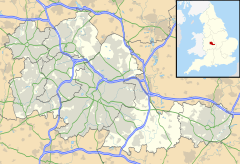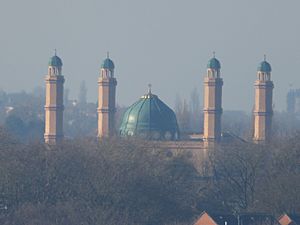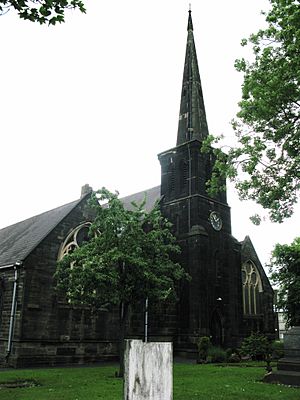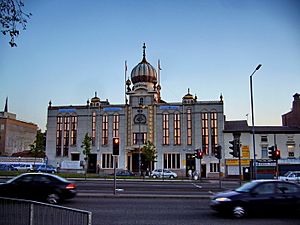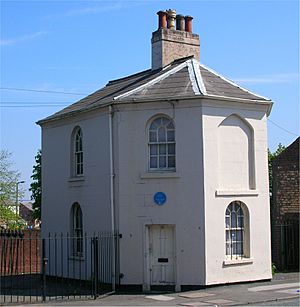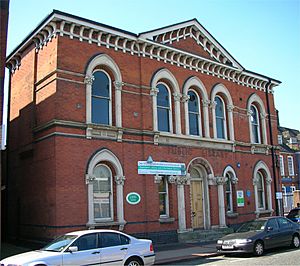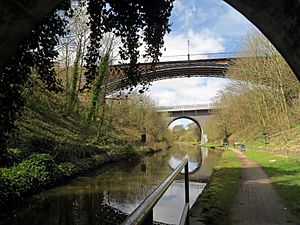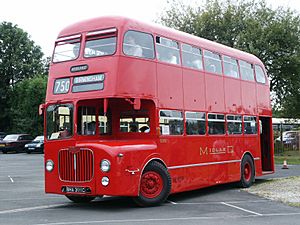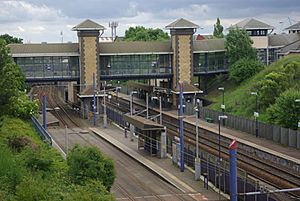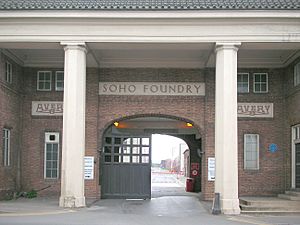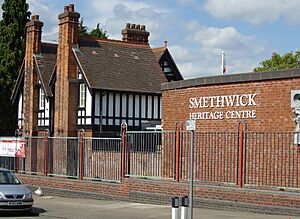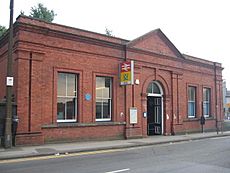Smethwick facts for kids
Quick facts for kids Smethwick |
|
|---|---|
| Town | |
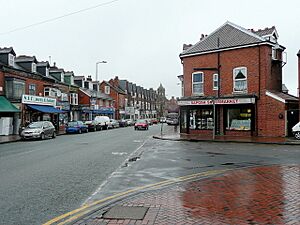 Waterloo Road, Smethwick |
|
| Population | 53,653 (2019 est, built-up-area subdivision) 15,246 (Ward) |
| OS grid reference | SP0287 |
| Metropolitan borough |
|
| Metropolitan county | |
| Region | |
| Country | England |
| Sovereign state | United Kingdom |
| Post town | SMETHWICK |
| Postcode district | B66, B67 |
| Dialling code | 0121 |
| Police | West Midlands |
| Fire | West Midlands |
| Ambulance | West Midlands |
| EU Parliament | West Midlands |
| UK Parliament |
|
Smethwick (/ˈsmɛðɪk/) is an industrial town in the Sandwell area of the West Midlands, England. It is about 4 kilometres (2.5 miles) west of Birmingham city centre. Smethwick used to be part of Staffordshire and then Worcestershire before becoming part of the West Midlands county.
In 2019, the Smethwick ward had about 15,246 people living there. The larger built-up area had an estimated population of 53,653.
Contents
- Smethwick's Past: A Brief History
- Smethwick's Buildings and Landmarks
- Smethwick's Political Journey
- How Smethwick Changed Over Time
- Getting Around Smethwick: Transport History
- Smethwick's Location and People
- Smethwick's Economy and Businesses
- Learning in Smethwick: Schools and Colleges
- Getting Around Smethwick: Modern Transport
- Sports in Smethwick
- Areas of Smethwick
- Famous People from Smethwick
- See also
Smethwick's Past: A Brief History
The name Smethwick might mean "smiths' place of work." However, a newer idea suggests it means "the settlement on the smooth land." Smethwick was mentioned in the Domesday Book (a very old survey of England) as Smedeuuich. For a long time, until the late 1700s, it was a small village connected to Harborne.
Early Industry and Inventions
The Smethwick Engine, the world's oldest working engine, was built by Boulton and Watt. It first stood near Bridge Street in Smethwick. Now, you can see it at Thinktank, a science museum in Birmingham.
The Fox Henderson Company, based in Smethwick, was famous for making the steel frame for the Crystal Palace. This amazing building was created for the Great Exhibition in 1851. Charles Fox, who started the company, also invented the first patented railway points.
Many other important factories were in Smethwick. These included companies that made railway parts, screws (like GKN), engines (from Tangye), and glass (from Chance Brothers). Chance Brothers even made the glass for the Crystal Palace. Phillips Cycles, once a huge bicycle maker, was also in Smethwick.
Homes and Community Changes
After 1920, council homes started to be built in Smethwick. The town's borders also grew in 1928, taking in part of Oldbury.
During the Second World War, Smethwick was bombed by German planes. Sadly, 80 people lost their lives in these air raids.
After the war, many people from Commonwealth countries came to live in Smethwick. A large group were Sikhs from Punjab, India. In 1961, the Sikh community bought a church and turned it into a gurdwara. The Guru Nanak Gurdwara Smethwick is believed to be the oldest and largest gurdwara in Europe.
In the 1960s, a big council estate called the West Smethwick Estate was built. It was known as the "concrete jungle" because of its concrete homes. These homes had problems, and by the 1990s, the council decided to knock them down. New, modern homes were built between 1993 and 1997, and the area was renamed Galton Village.
Smethwick's Buildings and Landmarks
The oldest building still standing in Smethwick is the Smethwick Old Church. It was built in 1732. The pub next to it is still called "The Old Chapel."
The Galton Bridge is a very important bridge. It crosses the New Line canal and railway. When it was built in 1829 by Thomas Telford, it was the longest single-span bridge in the world! It is named after Samuel Galton, a local landowner.
The public library on the High Street was first built as a Public Hall in 1866–67.
The Soho Foundry was opened by Matthew Boulton and James Watt in the late 1700s. In 1802, William Murdoch used his own invention to light the foundry with gas lighting. Today, the Soho Foundry is the main office for the Avery Company, which makes weighing scales.
Rolfe Street public baths were among the first public swimming pools in the country, opening in 1888. The building was later moved to the Black Country Living Museum in Dudley and opened there in 1999.
Smethwick's Political Journey
Smethwick has had an interesting political history. It became its own parliamentary area in 1918.
In the 1964 general election, there was a lot of discussion about immigration. Peter Griffiths, a Conservative candidate, won the election. Just nine days before he was assassinated, American civil rights activist Malcolm X visited Smethwick in 1965. He had an interview on the streets of Smethwick, which was his last TV interview.
How Smethwick Changed Over Time
Smethwick was originally a small village in Staffordshire. In 1894, it became an urban district, then a municipal borough in 1899, and a county borough in 1907. In 1966, Smethwick joined with Oldbury and Rowley Regis to form the new County Borough of Warley. This area then became part of Worcestershire. Finally, in 1974, Warley merged with West Bromwich to create the Sandwell Metropolitan Borough, which is part of the new West Midlands county.
Getting Around Smethwick: Transport History
Canals: Smethwick's First Highways
Smethwick has a long history with canals, which were the first big transport routes before good roads or railways existed. The Birmingham Canal Navigation Old and New Main Line Canals run through the town.
The old main canal line was finished in Smethwick by 1769. It needed 12 locks to go over the hill. Locks are like water elevators that help boats move up or down. The new main line, built by Thomas Telford and finished in 1829, went through a deep cutting instead of using locks. This cutting created the Galton Valley, and Galton Bridge was named after Samuel Galton, a local businessman.
Today, Galton Valley is a nature area. It is used more for fun and history than for moving goods.
Railways: Trains Arrive in Smethwick
The first railway through Smethwick was built in 1852 by the LNWR. It connected New Street to Wolverhampton. Stations like Rolfe Street and Spon Lane opened that year.
From 1854, the Birmingham Railway Carriage and Wagon Company was based in Smethwick. This company built not only trains but also London Underground parts, buses, and military equipment until it closed in 1963.
Today, there are three active railway stations in Smethwick.
Buses and Trams: Public Transport
Smethwick has a long connection with buses. The famous Birmingham and Midland Motor Omnibus Company (Midland Red) was based in Smethwick from 1914 to 1974.
Steam trams started running through Smethwick in 1885. These were replaced by electric trams in 1904. The last tram route in Smethwick closed in 1939 and was replaced by buses.
The Midland Metro, which opened in 1999, is like a light railway or modern tram. It follows an old railway track from Birmingham Snow Hill railway station to Wolverhampton. You can catch the Metro at Hawthorns railway station.
Smethwick's Location and People
Where is Smethwick?
Smethwick is next to West Bromwich and Oldbury to the north and west. To the south and east, it borders parts of Birmingham like Handsworth and Harborne.
Who Lives in Smethwick?
In 2011, there were 48,765 people living in Smethwick. The average age was 32.
People from many different backgrounds live in Smethwick:
- About 43.3% were White (mostly White British).
- About 37.5% were Asian (including Indian, Pakistani, and Bangladeshi).
- About 11.3% were Black (including Caribbean and African).
- About 4.7% were of Mixed background.
In terms of religion, about 39.5% of people were Christian, 21.8% were Muslim, and 15.7% were Sikh. Many people also said they had no religion.
Smethwick's Economy and Businesses
Until the late 1700s, Smethwick was mostly farmland.
The Soho Foundry, opened in 1796 by James Watt and Matthew Boulton, made steam engines. Today, it is the main office for the Avery Company.
One of Smethwick's most important businesses in the 1800s was the Fox, Henderson Company. They built the steel structure for the Crystal Palace in 1851.
Richard Tangye was a famous builder of steam engines in the late 1800s. He built his factory, the Cornwall Works, on the site of Smethwick Hall.
Mitchells & Butlers opened a brewery in Smethwick in 1879. It was a well-known landmark and provided many jobs for 123 years. However, it closed in 2002.
The courier company Interlink Express has its main office and distribution center in Smethwick.
The Smethwick Heritage Centre museum opened in 2004. It collects items about Smethwick's industrial and social history.
Learning in Smethwick: Schools and Colleges
Smethwick has many schools for different age groups:
- Abbey Junior and Infants
- Annie Lennard Infant School
- Bearwood Primary School
- Cape Hill Primary School
- Crocketts Primary School
- Devonshire Primary School
- Galton Valley Primary school
- George Betts Primary School
- Holly Lodge High School
- Ruskin House Pupil Ref. Unit
- St Gregory's Roman Catholic Primary School
- St Mathew's Church of England School
- St Phillip's Catholic Primary
- Sandwell Academy
- Shireland Collegiate Academy
- Shireland Hall Infant and Junior School
- Smethwick College (now part of Sandwell College in West Bromwich)
- Uplands Manor Primary School
- Victoria Park Primary School
Getting Around Smethwick: Modern Transport
Major Roads
The M5 motorway runs along the western side of Smethwick. You can get onto the M5 at Junction 1 (near West Bromwich) or Junction 2 (near Oldbury). Another important road is the A456 (Hagley Road), which goes from Birmingham through Bearwood.
Public Transport
Most local bus services are run by National Express West Midlands. Smethwick is on key bus routes, including the famous Number 11 Birmingham Outer Circle bus. There are also direct buses to places like West Bromwich, Wolverhampton, and Dudley.
Smethwick has three active railway stations:
- Smethwick Rolfe Street railway station: This station is mainly for local trains between Birmingham New Street, Wolverhampton, and Walsall.
- Smethwick Galton Bridge: This is a unique station built on two levels, serving two different railway lines. You can catch local trains here, plus direct long-distance services to places like Birmingham International, Shrewsbury, and even London at certain times.
- The Hawthorns: This station is near the West Bromwich football ground. It's on the same line as Galton Bridge and also connects with the Midland Metro, which links Birmingham and Wolverhampton.
Airports
The closest airport to Smethwick is Birmingham Airport, about 20 miles (32 km) to the east. You can get there by car via the M5, M6, and M42 motorways, or by train from Smethwick Galton Bridge or Smethwick Rolfe Street (with a change at Birmingham New Street).
Sports in Smethwick
Smethwick has a semi-professional association football club called Smethwick Rangers. They play in a regional league.
The Sandwell Aquatics Centre, which was used for the 2022 Commonwealth Games, is in the Londonderry area of Smethwick.
Smethwick Cricket Club is an amateur cricket club in the town.
The Hawthorns, which is the home stadium for West Bromwich Albion FC, is also partly located in Smethwick.
Areas of Smethwick
- Galton Village
- Bearwood
- West Smethwick
- The Uplands
- Londonderry
- Black Patch & Soho
- High Street Smethwick (including Victoria Park)
- Cape Hill, Windmill Lane and French Walls
- North Smethwick (Brasshouse Lane, Albion Estate, Hawthorns, Middlemore Estate)
Famous People from Smethwick
- Charles Douglas Fox (1843–1921), a civil engineer.
- Sydney Barnes (1873–1967), a famous England cricket player, was born in Smethwick.
- Harold John Colley (1894–1918), who received the Victoria Cross in World War I, was born here.
- Richard Swinburne (born 1934), a philosopher.
- Christine McVie (1943–2022), a musician and songwriter.
- Julie Walters (born 1950), a famous actress, spent her early years in Bearwood, Smethwick.
- Patrick Cowdell (born 1953), a British boxer.
- Lee Hughes (born 1976), a professional football player.
See also
 In Spanish: Smethwick para niños
In Spanish: Smethwick para niños


